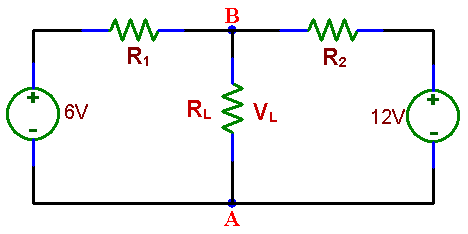Measure the voltage between points
A and B, with RL infinite (open circuit):
a) With both sources in the circuit
b)
With only one of the sources in
the circuit while the other is replaced with a wire ("short circuit").
Read the warning below before making these two voltage measurements.
Warning:
do not short the power supplies
when replacing it with a short circuit!
Disconnect them
first from the circuit.
c)
Repeat a) and b) after
connecting a resistor RL (in 3k to 20k range) between points A and B. After the
measurements put aside this resistor; you will need it again in part 2.
Check that the measurements a) and
b), without RL, and measurements c), with RL, agree with the superposition principle. Calculate any discrepancy in % and
comment if it is reasonable, based on the precision of your instruments.
Compare also the measured value of VL
with calculations for a circuit with two sources.
